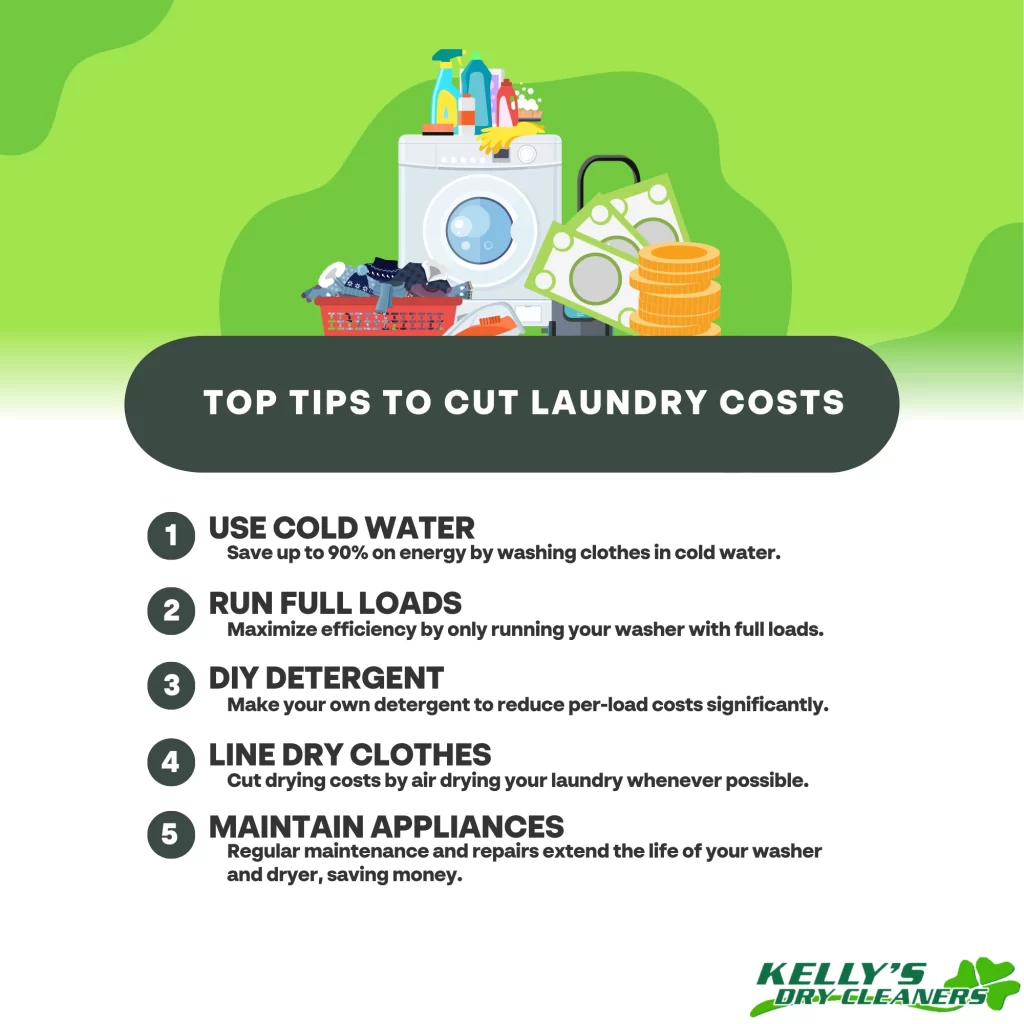You can save on laundry costs by adopting energy-efficient practices like using cold water and running full loads to maximize resources. Choose Energy Star appliances for long-term savings despite the upfront cost. Use high-efficiency detergent sparingly and consider making your own to cut costs. Line dry clothes when possible and use natural softeners like white vinegar or wool dryer balls. Maintain your washer regularly and repair it instead of replacing it to prolong its lifespan. Skipping fabric softeners helps maintain garment quality. Explore these strategies for smarter, more economical laundry routines.
Key Takeaways
- Use cold water for washing to save up to 90% of energy per load.
- Only run full loads to maximize water and electricity efficiency.
- Opt for Energy Star appliances to reduce long-term energy and water usage.
- Make your own laundry detergent to significantly cut per-load costs.
- Line dry clothes to eliminate drying expenses and reduce energy use.
Use Cold Water
One of the simplest yet most effective ways to reduce your laundry costs is to use cold water. Switching to cold water can greatly cut down on the energy expenditure required to heat the water. If you’re wondering how much does it cost to wash a load of laundry, heating the water often accounts for the largest portion of that expense. By opting for cold water, you can save up to 90% of the energy used per load.
When considering how much does one load of laundry cost at home, using cold water can make a noticeable difference. Typically, washing and drying a load of laundry at home can cost anywhere from $0.50 to $0.75, depending on your local energy rates. By using cold water, you can shave off a good portion of these costs, especially if you do multiple loads a week.
Moreover, cold water is gentler on fabrics, meaning your clothes will last longer, reducing the frequency of replacements. Strategically using cold water doesn’t just save money on each load; it also extends the life of your garments, contributing to long-term savings. So next time you do laundry, consider the benefits of cold water.
Full Loads Only
Maximizing the efficiency of your laundry routine involves washing only full loads. This strategy not only saves water and energy but also reduces wear and tear on your machine. Understanding how much it costs to wash and dry a load of laundry at home can highlight the importance of this practice. Let’s break it down:
- Water Usage: Each load uses a significant amount of water. By filling your machine to capacity, you’ll use less water per item washed.
- Energy Consumption: The energy required to heat the water and run the machine is almost the same for half and full loads. Maximizing each load means fewer washes, saving on energy bills.
- Detergent Efficiency: Detergent is most effective when used in the recommended amounts for full loads, guaranteeing you get the best cleaning performance without waste.
- Cost Savings: When you consider how much it costs to wash a load of laundry and how much it costs to wash and dry a load of laundry at home, running fewer, fuller loads can lead to noticeable savings over time.
Efficient Detergent Use
Efficient detergent use is a crucial aspect of cutting laundry costs without sacrificing cleanliness. It’s easy to over-pour detergent, thinking more means cleaner clothes, but that’s not the case. In fact, using too much detergent can leave residues that attract more dirt, causing you to wash clothes more frequently, thereby increasing costs.
To determine how much detergent you actually need, follow the guidelines on the detergent packaging. Most modern washing machines are designed to work with high-efficiency (HE) detergents, which require less product. A small, measured amount is usually sufficient for a full load.
Understanding how much does it cost to wash a load of laundry at home will help you see the financial impact. Typically, it costs between $0.50 to $1.00 per load, but this can increase considerably with excess detergent use. By using the right amount, you’ll optimize your expenses.
Moreover, consider the combined cost when you wash and dry a load of laundry at home, usually ranging from $1 to $2 per load. Efficient detergent use%20laundry,water%20environments%20of%20HE%20machines.) not only keeps your clothes in better condition but also guarantees that each load is as cost-effective as possible.
Line Dry Clothes
Hanging your clothes to dry can greatly slash your laundry expenses while also benefiting the environment. The cost to wash and dry a load of laundry at home typically ranges from $0.50 to $1.00, depending on energy prices and your machines’ efficiency. By line drying, you eliminate the drying cost, potentially halving your expenses. Here’s a strategic approach to maximize savings and efficiency:
- Use a Sturdy Clothesline or Rack: Invest in a durable clothesline or drying rack. While there’s an upfront cost, the long-term savings make it worthwhile.
- Optimal Placement: Place your clothesline in a sunny, well-ventilated area. Sunshine not only speeds up drying but also naturally sanitizes your clothes.
- Timing: Plan your laundry around the weather. Check forecasts to confirm sunny or breezy days for the fastest drying time.
- Clothes Care: Shake and hang clothes properly to minimize wrinkles, reducing the need for ironing, which consumes additional energy.
Maintain Your Washer
Maintaining your washer is vital for long-term savings and efficiency. Regular maintenance guarantees your machine runs smoothly, which directly impacts how much it costs to wash a load of laundry. Start by routinely checking hoses for leaks or wear and tear. A simple fix can prevent water damage and costly repairs down the line.
Cleaning the washer drum is another significant step. Residue from detergents and fabric softeners can accumulate, leading to mold and unpleasant odors. Running an empty cycle with a specialized washer cleaner or a mixture of vinegar and baking soda can keep the drum fresh and operational.
Don’t overlook the lint filter if your washer has one. A clogged filter can reduce efficiency, making each load more expensive. Additionally, periodically check the water inlet filters to verify they aren’t blocked by mineral deposits, which can affect water flow and washing performance.
Choose Energy Star
Why consider Energy Star appliances for your laundry room? Energy Star-rated washers and dryers are designed to use less water and energy, translating into significant cost savings over time. Given that the average cost to wash and dry a load of laundry at home ranges from $0.50 to $1.50, these savings can add up quickly.
Here’s how Energy Star appliances help you save:
- Reduced Energy Consumption: Energy Star washers use about 25% less energy than conventional models. This directly impacts how much it costs to do laundry by lowering your electricity bill.
- Water Efficiency: These washers use 33% less water, which reduces your water bill and helps conserve this precious resource.
- **Advanced Technology: Features like moisture sensors in Energy Star dryers guarantee clothes aren’t over-dried, saving energy and extending the life of your garments.
- Long-Term Savings: While the initial cost might be higher, the reduced costs per load of laundry mean you’ll recoup the investment in a few years.
DIY Laundry Detergent
Making your own laundry detergent is a smart way to cut costs, and you’ll only need a few simple ingredients like washing soda, borax, and a bar of soap. By following some straightforward, step-by-step instructions, you can create an effective detergent at a fraction of the price of store-bought options. Plus, it’s an eco-friendly choice that lets you control exactly what goes into your laundry routine.
Simple Ingredients Needed
Creating your own laundry detergent can be both a cost-effective and environmentally friendly solution. Given the rising costs of household necessities, understanding how much does a load of laundry cost becomes vital. On average, how much does it cost to wash a load of laundry at home might surprise you—typically around $0.21 to $0.51 per load. By concocting your own detergent, you can drastically reduce these expenses.
To start, you’ll need only a few simple ingredients. Here’s a concise list to guide you:
- Washing Soda: This alkaline compound helps to remove grease and stains, enhancing the cleaning power of your homemade detergent.
- Borax: An effective natural cleaner and deodorizer, borax is a staple in many DIY cleaning recipes.
- Soap: Opt for a mild, unscented soap or a soap specifically designed for laundry. Grated soap bars work best for easy mixing.
- Fragrant Oils (optional): For a pleasant fragrance, add a few drops of fragrant oils like lavender or tea tree.
Step-by-Step Instructions
Now that you’ve gathered your simple ingredients, let’s walk through the process of making your own laundry detergent step-by-step. Start by grating one bar of soap into fine particles. Use a cheese grater or food processor for this task. Next, measure one cup of washing soda and one cup of borax. Combine the grated soap, washing soda, and borax in a large bowl and mix thoroughly.
Transfer the mixture into an airtight container, such as a large glass jar. To use, add one to two tablespoons of this homemade detergent per load, depending on the size and dirtiness of your laundry. This mixture should last for about 40 loads, making it incredibly cost-effective.
When considering how much does it cost to wash a load of laundry, this DIY detergent can save you a significant amount. On average, using commercial detergents can cost around $0.20 per load. By making your own, you reduce this to approximately $0.05 per load. Combined with the electricity and water costs, understanding how much does it cost to wash and dry a load of laundry at home becomes crucial. Saving on detergent is a strategic way to lower how much does one load of laundry cost at home.
Skip the Fabric Softener
Skip the fabric softener and consider natural alternatives like vinegar or baking soda to keep your clothes soft. Not only will you reduce the chemical residue left on your fabrics, but you’ll also extend their lifespan. Plus, you’ll save money and promote a healthier home environment.
Natural Softening Alternatives
Your laundry routine doesn’t have to rely on store-bought fabric softeners to achieve soft, fresh-smelling clothes. Embracing natural softening alternatives can not only improve your laundry but also help you save money. Considering how much does it cost to wash and dry a load of laundry at home, every penny saved is worthwhile. On average, how much does one load of laundry cost at home? Around $0.97, including detergent and electricity. Here are some natural options to keep your clothes soft without adding to that expense:
- White Vinegar: Add half a cup of white vinegar to the rinse cycle. It naturally softens fabrics and eliminates odors.
- Baking Soda: Half a cup of baking soda in the wash can soften clothes and boost detergent effectiveness.
- Wool Dryer Balls: These reusable balls reduce drying time and soften clothes without chemicals.
- Fragrant Oils: A few drops of your favorite fragrant oil on wool dryer balls or a damp washcloth can leave clothes smelling fresh.
Reduce Chemical Residue
While natural softening alternatives offer a great way to improve your laundry routine, another significant aspect to take into account is reducing chemical residue on your clothes. Skipping fabric softeners not only keeps your garments cleaner but also saves you money. Fabric softeners often contain chemicals that can coat fibers, potentially causing skin irritation and reducing the absorbency of towels and activewear.
Understanding how much does it cost to wash and dry a load of laundry at home is crucial for making frugal choices. Typically, one load of laundry costs around $0.50 to $1.00 for both washing and drying, not including detergents or fabric softeners. By skipping fabric softeners, you can reduce this cost. Instead, you can use white vinegar during the rinse cycle, which softens clothes naturally without leaving a harmful residue.
Additionally, fabric softeners can gum up your washing machine, leading to more frequent maintenance and higher costs in the long run. Considering how much does one load of laundry cost at home, cutting out fabric softeners is a strategic way to save. This small change can lead to significant savings while guaranteeing your clothes are clean and residue-free.
Extend Fabric Lifespan
Preserving the integrity of your garments is essential for extending their lifespan, and one effective strategy is to forgo fabric softeners. While fabric softeners promise softer clothes, they often leave a residue that can deteriorate fabric over time, shortening the life of your clothes and adding to your laundry costs. So, how much does a load of laundry cost? It’s not just the water and electricity; frequent replacement of worn-out clothes adds up too.
Here’s why skipping fabric softener can be beneficial:
- Preserves Fabric Quality: Fabric softeners coat fibers with chemicals that can break down fabric strength over time.
- Reduces Allergies: Residues from fabric softeners can cause skin irritations and allergies, leading to potential medical expenses.
- Cost Efficiency: By maintaining the fabric’s integrity, you’ll replace clothes less often, saving money.
- Eco-friendly: Reducing chemical use is better for the environment and your health.
Wondering how much does it cost to wash a load of laundry or how much does it cost to wash and dry a load of laundry at home? You can cut costs considerably by extending the lifespan of your clothes. Skipping fabric softeners is a small step with significant rewards.
Optimize Washing Cycles
Optimizing washing cycles can greatly cut down on laundry expenses while maintaining the quality of your clothes. The first step is understanding how much it costs to wash a load of laundry. On average, it costs about $0.21 per load for water and $0.22 for electricity, totaling roughly $0.43 per load. When you factor in drying, the cost can rise to around $1.50 per load at home. However, by strategically choosing your washing cycles, you can reduce these costs.
Start by selecting the shortest cycle that still gets your clothes clean. Many modern washing machines have eco-friendly settings that use less water and energy. Use cold water whenever possible; it’s just as effective for most loads and considerably reduces energy usage. Additionally, make sure to only run full loads. Washing partial loads wastes both water and electricity, driving up your costs unnecessarily.
Invest in high-efficiency (HE) detergents, as they require less water for rinsing. Combining these strategies can lead to substantial savings over time. By optimizing your washing cycles, you’ll not only save money but also extend the lifespan of your washing machine and reduce your environmental footprint.
Repair Over Replace
Repairing your laundry appliances instead of replacing them can be a strategic way to save significant money. Given that the cost to do laundry at home can add up, it’s essential to evaluate repair options first. On average, how much does it cost to wash and dry a load of laundry at home? Estimates range from $0.50 to $1.50 per load, factoring in water, electricity, and detergent. When your appliances break down, the immediate thought might be to replace them, but repairs can often be more economical.
Here are four strategic reasons to repair over replace:
- Cost Efficiency: Repairs typically cost less than purchasing a new appliance. Even a high repair bill is usually cheaper than the price of a new washer or dryer.
- Environmental Impact: Repairing extends the life of your appliances, reducing waste and the carbon footprint associated with manufacturing and disposing of large appliances.
- Performance: A well-repaired machine can perform just as efficiently as a new one, maintaining the lower end of how much does one load of laundry cost at home.
- Convenience: Coordinating a repair can often be quicker than shopping for and installing a new appliance, saving both time and hassle.
Conclusion
You’ve got the tools to trim those laundry costs! By being strategic and sensible, you’ll see significant savings. Cold water, full loads, and efficient detergent use all add up. Line dry and maintain your machines to maximize their lifespan. DIY detergents and skipping fabric softeners save cents and the environment. Optimize cycles and repair, don’t replace, to reduce waste. By adopting these detailed, deliberate decisions, you’re not just saving money—you’re being smart and sustainable.



